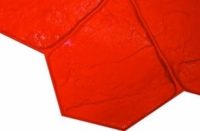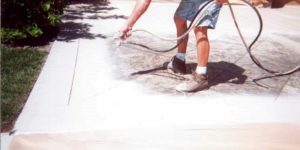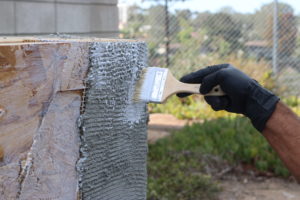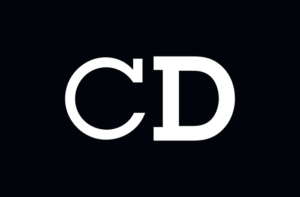
Stamped concrete, also known as textured or embossed concrete, is the most recognized decorative concrete finish. It is also often the first thing people think of when saying the term “decorative concrete.” It is often considered the foundation of decorative concrete.
A case can be made that in 1970 the decorative concrete industry truly began when the Bomanite Co., using Brad Bowman’s patents, franchised the process of stamped concrete. It’s been 50 years since those first pioneering companies colored and textured concrete. A lot has changed since then.
Stamped concrete might not make the front page of magazines anymore, but it remains a large part of our industry. With that in mind let’s have a look at a few of the biggest changes and innovations in the stamped concrete market over the last five decades.
Integral color versus color hardener
“Color hardener was for years the only way to color concrete when it came to stamping,” says Karen Keyes, owner of The Art of Concrete in Denver, Colorado.
For decades, throwing color hardener was just part of the stamped concrete system. Aside from the added strength and vibrant colors, many installers claim the imprint they achieved with a color-hardened surface was cleaner and more defined. That all changed with the introduction of automated color-dosing systems in the early 2000s.
The ease of automated color dosing reduces inventory and labor, not to mention the mess of dealing with color hardener on the job site. Today a vast majority of colored concrete, including stamped concrete, is produced using integral color.
Keyes adds that she’s seeing a resurgence of color hardener in specialty applications. “When customers want a custom color, or a blend of colors, we use color hardener as an alternative method to color concrete.”
Post coloring progress
“Highlighting” or “antiquing” stamped concrete is what gives the product its characteristic realism. Without these secondary color highlights, stamped concrete would lack authenticity or natural appeal.
Early stamped concrete didn’t require any secondary color highlights, as the patterns comprised basic tile, cut stone or brick that had no texture. With the advent of textured stamp tools, the need was born for secondary color highlights.
The original method, still used today, was to cover the surface with a contrasting colored powder that was hydrophobic (repels water). This colored “antiquing release powder” allows textured stamp tools to be placed on green concrete to emboss the surface with a pattern, but not stick when removed.
In the process, the stamp tools’ texture physically forces some of the colored release into the concrete paste creating a secondary color highlight. Excess release powder is removed, resulting in a realistic multicolored, textured and patterned surface. As with color hardener, this is a messy process, as the color is usually hand broadcast on the concrete surface before stamping.
About 10 years ago, liquid-applied post-coloring systems appeared, eliminating the need for release powder. These systems let the installer use a clear liquid release to stamp the concrete. They then come back and post-color the surface with a liquid color system.
There is significant change in this process. From the way concrete is stamped and post-colored, to cleaning up and streamlining the process significantly.
The evolution of tools
Over the last 50 years the single biggest area of innovation and change in the stamped concrete market is the stamp tool itself. They originally made stamping tools from wood and aluminum. The first stamp tools of the ’50s and ’60s were designed to impart only a pattern, no texture. They were rigid and heavy, limiting patterns to squares and rectangles.
In the late 1970s, Joe Nasvik developed the first rubber urethane concrete stamp tools. These new-generation tools were flexible. They also had rounded edges and imparted textures as well as patterns into the concrete. This revolution in tooling opened up the industry to the endless number of patterns and textures used today.
In the 2000s another expansion took place as multiple companies developed and marketed specialty tooling for step risers, countertop edges and vertical work. This allowed stamping to grow into new markets and increased a project’s realism and level of detail.
Proline Concrete Tools developed the most recent innovation in stamp tools a few years ago. Magnetic seamless pattern stamps are a patented system uses magnets in large seamless stamp tools. This makes alignment easier. Thus, making the whole stamping process more efficient.
Past should be part of the present
What we as an industry can’t do is forget our past. Specifically the finishes that are the very foundation of who and what the decorative concrete industry is. Stamped concrete, while not the only decorative finish, arguably is the cornerstone of our industry.

“We like that the mats are larger than traditional ashlar mats. That means moving mats less frequently and stamping larger areas faster,” was the feedback from C.J. Salzano of Salzano Custom Concrete in Aldie, Virginia.
As with any new system, there’s a learning curve, he says. He had to make some “creative adjustments” to the tools to accommodate their stamping process.
“Most of the disadvantages are growing pains and becoming familiar with something different.” Salzano says in summary of his experience with the magnetic seamless pattern stamps.
To sum up Anderson’s point, stamped concrete has become a mainstream hardscape finish. It is no longer as exciting and new as it was back in the early 2000s. However, it remains the lifeblood for so many installers, suppliers and manufacturers. We should neither forget stamping nor ever take it for granted.
A note from the author
The hardest part about writing a regular column is coming up with relevant subjects. I try not to repeat topics too often as you can only read so many articles about sealer issues.
As I begin year 12, new ideas are harder to come by. I often find myself stressing as the due date approaches, still searching for a topic to address. This time, a recent conversation with John Anderson, a friend and the former business development manager for Solomon Colors, was just the needed spark. He mentioned how the decorative industry can’t forget what got us to where we are today — specifically stamped concrete.
This immediately presented itself as a good topic for an article.
Questions from Readers
What are the best name-brand color release powders, sealers and spray on the market?
Answer from Concrete Decor
There are many good brands on the market for color hardeners and color releases. You aren’t going to experience many notable differences among products in this category.
With respect to sealers for concrete, there’s a little more volatility in this camp. However, most sealer manufacturers want to ensure that your concrete looks good when you apply their products. Often the case of quality rests with the applicator. Several light coats are always better than one heavy coat and back rolling to eliminate puddling is critical.
Sealers also come in solvent- and water-based formulations. Solvent-based materials will darken or enrich the color of your concrete. Water-based sealers don’t change the color of the concrete.
You can also choose between penetrating and film-forming solutions. Penetrating formulations won’t leave a film on the surface. With film-forming sealers, it’s best to add a slip-resistant additive if slip fall issues are a concern.
We sell good quality products via the Concrete Decor Store along with slip-resistant additives if you’re interested in buying online. We’re one of the most reputable online services to the concrete construction industry.
















